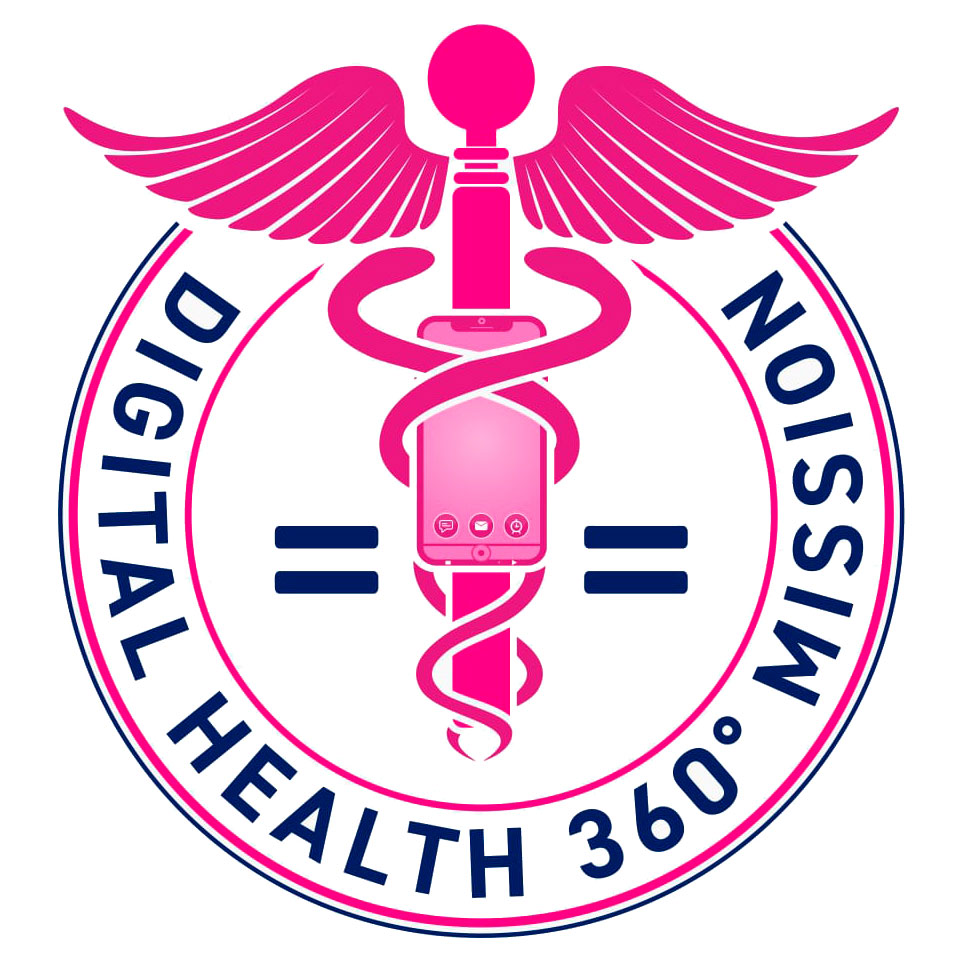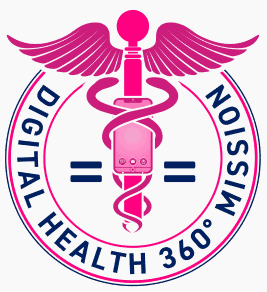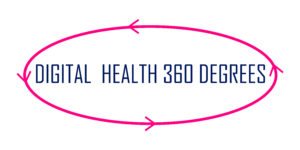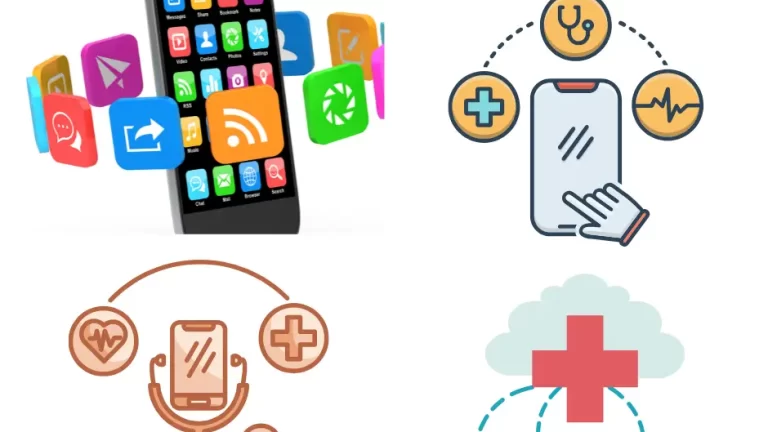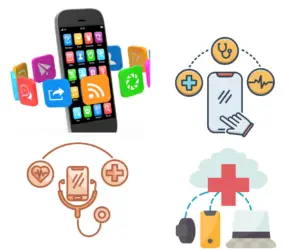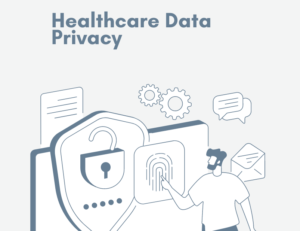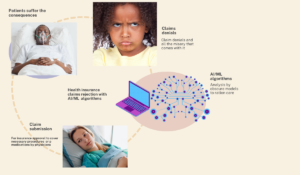Unlocking choices: How medical Apps transform chronic disease management
Our U.S. chronic disease burden, coupled with an aging population and a looming healthcare staff shortage, does not augur well for our population’s health. We aim to counter this impending public health inadequacy by implementing various digital health solutions.
Direct-to-consumer mobile health applications (mHealth apps) are a significant part of our digital health arsenal and are becoming increasingly accepted by the population.
More than half of smartphone users in the U.S. have downloaded at least one mHealth app. There is also an overabundance of mHealth applications, with over 350,000 mHealth apps available in the app stores[1,2].
Although their efficacy is not fully established, they have shown some positive therapeutic effects in chronic health conditions like diabetes, Asthma, COPD,
and mental health disorders like diabetes and anxiety[1].
They have also increased access to care in high shortages of healthcare personnel. Some mental health therapy apps came in as a good supplement to many folks struggling with pandemic-induced anxiety and depression during the height of the COVID-19 pandemic[3]. Additionally, they can engage patients more effectively while positively influencing their healthy behaviors[4].
Nevertheless, despite their abundance and potential benefits, there are concerns that most mHealth apps are ineffective, have questionable clinical utility, and are outright harmful[5]. Many are of low quality, not evidence-based, and are produced without consideration for the characteristics of their intended end users [6].
No consensus metrics exist in the public domain for evaluating and assessing the effectiveness of available mHealth apps [7].
In addition, more than 90% of mHealth Apps in app stores are not regulated like drug development. Most mHealth Apps are not evidence-based and may harm the user by giving a false sense of effectiveness [5].
The present glut of medical apps without corresponding easy-to-use assessments beyond those in academic journals[8] leaves individuals confused and overwhelmed without concrete ways of knowing what works. Users and clinicians are left to rely on the marketing materials in the app stores, which have an overinflated sense of usefulness that is not backed by clinical evidence[5].
This write-up intends to guide the individual user on critical factors to consider before choosing any mHealth app. It is also essential for clinicians responsible for recommending the right app for their patients.
Discover the power of mHealth Apps: Categories and types explained
Various mHealth apps can be categorized based on their regulations or oversight, clinical objectives, impact stage in the continuum of medical conditions, and intended stakeholder for app use.
Based on regulatory oversight, most mHealth apps are not FDA-regulated and lack specific oversight beyond the standards of the app store. Few apps are considered digital therapeutics(DTx) and are FDA-approved based on relative scientific rigors of evidence. They may need some form of clinician prescription to use.
mHealth apps based on objectives can be motivational apps to help with behavioral modifications to achieve a goal, structural organizers and reminders, diagnostics, or severity determination.
Apps can also be categorized based on the stage at which they impact clinical conditions. Generally, they can fall under apps used in the pre-morbid state: apps for prevention, behavioral modification, and diagnostics. Apps in the morbid and post-morbid state of clinical conditions function to reduce the severity of diseases, monitor progression, monitor the impact of therapies, and determine severity.
The app categorization based on intended stakeholders; most apps are designed for use by individuals/patients. There are also apps intended for clinicians to use. These are for tasks like clinical decision support, research, diagnosis, patient monitoring, e.t.c
Unleash health App success by mastering the art and science of choosing the mHealth App that is right for you.
Our recommendations for the mHealth app choice are based on our digital health 360-degree methodology, a simplified holistic approach to digital health assessment. The various components are listed below.
- Intact value proposition of the mHealth app;
The definition of value in digital health is up for debate. Nevertheless, it is evidence of relatively high effectiveness with the least resources to achieve a therapeutic objective. Based on this premise, the screening questions to determine value are below.
a) Is there any evidence of the effectiveness of the mHealth App?;
I)What is the app’s basic theory/ clinical framework? Is it built on an evidence-based theory with known effectiveness? For example, a weight loss app built on the Mediterranean diet or intermittent fasting is bound to be effective, as these methods have a solid scientific basis.
II)Any independent clinical trial comparison of the app with the status quo. If there is a trial, the next question will be how independent where the investigators who conducted the trial?. Are they sponsored by the app vendors/developers or the app company?
III)Measurable and achievable goals: Did the app developers declare measurable and attainable goals versus just hype of marketing materials without substantial objectives? For example, a good goal pronouncement will sound like this: mHealth app X, when used as directed, can lower your A1c by 2 points over 6 months.
IV)Prior users’ and clinicians’ opinion of the app: For effectiveness, it is more worthwhile to rely on direct word of mouth from a previous user than random online reviews. It’s also worth noting that factors like compliance level and intrinsic human physiologic or pathologic variance can produce different outcomes in two people with similar health profiles using the same mHealth app. Like every therapy, it is also essential to seek the opinion of your clinician when choosing any mHealth app.
b) Adoption rate of mHealth App: Is it actively used by individuals who downloaded it? There is a high rate of lack of compliance with medical apps. The fact that there are millions of downloads of an app does not translate to its active use by folks who downloaded the mHealth app from the app store. Also, you should be wary of online reviews, as there are online marketplaces where vendors can buy reviews from actual web users.
2.Quality and safety criteria of mHealth App:
a) Direct medical safety and prevention of adverse effects built in the App: This answers how much effort was put into preventing harm to users by app developers. Measures like alerts to notify users when the app is malfunctioning and notifications to users to seek direct medical care when they are not achieving the goal of therapy.
Also, are there measures to prevent harm specific to their condition, like preventing suicide in patients with depressive disorder?
This category also includes the app’s technical reliability, including the frequency of glitches, error messages, and percentages of non-functioning features that may cause preventable harm to the user.
b) Data safety, cyber security, and confidentiality of mHealth App: How much effort was put in by developers to protect users’ data by encryption and other industry best practices to protect data? Also, does the app have a robust data privacy and confidentiality policy that explicitly details what the company does with user’s data?
Do they share and sell data to third parties? Are users able to permanently delete their data from the app?
Did their privacy policy explain the security measures well and declare whether their data storage is cloud-based or on-site?
c). Usability and ease of use of the mHealth app: Usability in this context emphasizes Usability for safety and harm prevention and not aesthetics design. Generally speaking, Usability is determined by efficiency, efficacy, and user satisfaction [9,10]. There is more to evaluating Usability beyond the scope of this write-up [11,12].
For the sake of brevity, the questions to consider include: Are the menus and labels clear, logical, and hierarchically organized? Are the icons intuitive and not confusing? Are the icons’ styles consistent and easy to decipher? Are screens easy to navigate? Are there accessibility considerations (sound for the visually impaired and ability to change fonts)?
3) Ethical, cost, and environmental considerations for the App;
These outlined factors are also indirectly related to the effectiveness of any digital health tool.
a) Does the app worsen health inequity? Is it available to only to folks with certain type of insurance coverage or geographical location?
b) Does the app require an unreasonable amount of data resources to run?
c) Is it available only on specific platforms, e.g., some apps run only on the iPhone? Is the premium subscription reasonably priced?
Digital Health 360 Degrees Criteria for Choosing a Medical App (mHealth App)
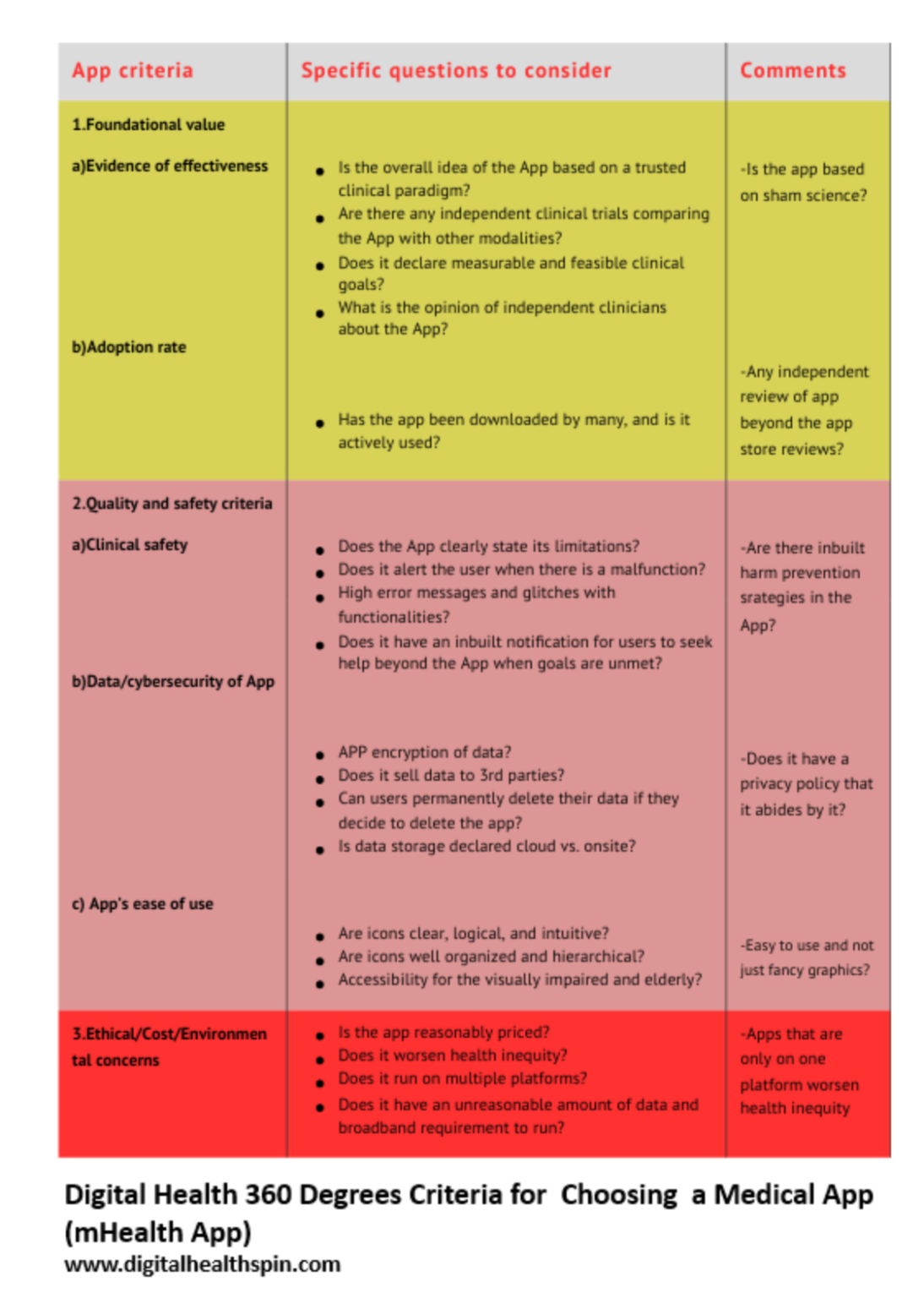
The path to achieving good health is not a linear trajectory, as individuals with similar conditions may have different outcomes using the same health App
Ahmed-Digital Doc Tweet
Digital health 360 degrees lens
As our computing power continues to increase, mHealth app will also surge with more complicated functionality over time. They are promising in improving health and increasing health access; however, there are many concerns about their lack of concrete evidence for their safety and effectiveness. Other issues are their lack of integration with healthcare delivery systems and threats to safety and privacy[13].
The most significant risk we face with mHealth apps is the lack of easy-to-use consensus criteria for objective assessment of these apps despite their ubiquity. Most evaluation methodologies are in research papers that are out of reach or too complicated for the average user to decipher. This leaves individual users confused and overwhelmed with the multitude of options.
They are left with relying on the app’s marketing materials, usually hyped claims of effectiveness. The same fate also befalls clinicians whose patients ask about health app recommendations. Evaluating digital health tools and determining their effectiveness is a contemporary burden they face without initial training.
To overcome this gap in evaluation tools, we have distilled the various app assessment tools in the literature down to 3 criteria to compare apps. The basic questions are: What is the specific value proposition of the app?(Are they based on well-established therapeutic evidence)? Is the app medically and cybersecurity/data safe? Does the app worsen health disparity and amplify the unethical status quo?
It is also essential to add that your final app choice should depend on the overall objective and goals you want to achieve in lieu of the app category described above. Apps used in the morbid and post-morbid phases should undergo more scrutiny, and your clinician should be involved in the decision process.
These categories of Apps pose a higher risk profile than pre-morbid apps, which are mostly for prevention and lifestyle modifications.
References;
